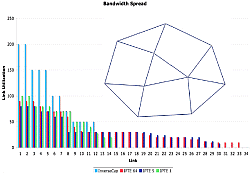MESCAL’s
intra-domain traffic engineering approach is based on layer 3 mechanisms
(rather than MPLS-TE, for example). Its purpose is to compute a
set of OSPF link weights to balance network load while honouring
the QoS constraints of the traffic; and to provide answers to “what
if” scenarios posed by Inter-domain Traffic Engineering in order
to coordinate and optimise inter-domain and intra-domain traffic
engineering decisions.
The IPTE approach is built on classical OSPF routing, but additionally
introduces DSCP based routing to form multiple OSPF routing planes
in the network. Each DSCP plane has individual link weights and
can thus route traffic independently of the other planes. Each plane
may be used to route traffic of an equivalent QoS-class to meet
the performance constraints of that class. Another benefit of this
approach is that multiple routing planes – even for a single QoS-class
– allow for better load balancing across an AS.
The IPTE algorithm runs off-line at Resource Provisioning Cycle
epochs. Given a traffic demand matrix and the network topology,
the algorithm computes a set of link weights using a search heuristic.
The optimisation is cost function based, so that individual QoS
class constraints as well as other optimisation goals can be taken
into account by factoring them into the algorithms cost function.
This allows for parallel existence of hop-count-constrained, bandwidth-constrained
and best effort traffic classes.
Because the solution relies on IP routing, the IPTE approach is
more lightweight than MPLS-TE in terms of state-information required
to be maintained in the network and the associated management configuration
overhead for establishing LSPs. Since QoS information remains at
the management layer in the off-line algorithms, no QoS awareness
is required at layer 3. Recent MT-OSPF Internet Drafts provide the
required DSCP based routing support, so potentially no major changes
at the router level are required for the approach to be implemented.
 The
IP-based Intra-domain traffic engineering simulations show that
DSCP aware routing can successfully be used for providing individual
routing to different traffic classes. Bandwidth- as well as hop-count-optimised
routing classes can be configured to run in parallel on the same
physical network, using the link weight optimisation techniques
proposed in deliverable D1.2. In addition the simulations show that
the load is balanced more evenly across the network than with standard
shortest path routing on inverse capacity link weights. Simulations
have demonstrated that the approach is scalable to large ASs consisting
of 100s of routers. The
IP-based Intra-domain traffic engineering simulations show that
DSCP aware routing can successfully be used for providing individual
routing to different traffic classes. Bandwidth- as well as hop-count-optimised
routing classes can be configured to run in parallel on the same
physical network, using the link weight optimisation techniques
proposed in deliverable D1.2. In addition the simulations show that
the load is balanced more evenly across the network than with standard
shortest path routing on inverse capacity link weights. Simulations
have demonstrated that the approach is scalable to large ASs consisting
of 100s of routers.
Further
reading:
MESCAL
deliverable D1.3, "Final specification of protocols and algorithms
for inter-domain SLS management and traffic engineering for QoS-based
IP service delivery", Chapter 10, section 10.6. [link]
MESCAL
deliverable D3.2, "Final
experimental results: validation and performance assessment of algorithms
and protocols for inter-domain QoS through service-driven traffic
engineering",
Chapter 3, section 3.3. [link] |